
The Elsinore Theatre is a 1,290-seat theatre located in Salem, Oregon, United States, that first opened on May 28, 1926.
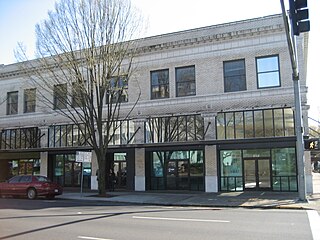
The Capitol Theater was located at 542 State Street in Salem, Oregon, United States. Part of the Bligh Building, it was built in the 1920s for vaudeville. During its heyday, it housed a Wurlitzer pipe organ, which is now in private ownership in Washington. The theater was demolished in 2000, but the retail portion of the building, now known as the Pacific Building, still stands.

The Union Trust Building is a high-rise building located in the Downtown district of Pittsburgh, Pennsylvania, at 501 Grant Street. It was erected in 1915–16 by the industrialist Henry Clay Frick. The Flemish-Gothic structure's original purpose was to serve as a shopping arcade.

The Missouri Theatre, is a concert and entertainment venue in downtown Columbia, Missouri, occupying most of a city block between 9th street between Locust and Elm Streets. It was designed after the Opéra Garnier by the Boller Brothers, built in 1928, and is on the National Register of Historic Places. It is Columbia's only surviving pre-Depression movie palace and vaudeville stage. In 2011, the University of Missouri began a three-year lease of the facility. The Missouri Theatre is the resident home of the Missouri Symphony Orchestra, and is also frequently used by University of Missouri and civic groups. As of July 1, 2014, The University of Missouri took over ownership of the Missouri Theatre. It is one of the main performance venues for the University of Missouri School of Music.

Church Street United Methodist Church is a United Methodist church located on Henley Street in downtown Knoxville, Tennessee. The church building is considered a Knoxville landmark and is listed on the National Register of Historic Places.

Merchants National Bank is a bank building in Winona, Minnesota, United States, designed in the Prairie School architectural style. It was built in 1912 and features elaborate terracotta and stained-glass ornamentation. It was listed on the National Register of Historic Places in 1974 for having state-level significance in the themes of architecture and commerce. It was nominated for being the "largest and probably best example" of the 18 Midwestern banks designed by Purcell, Feick & Elmslie, a significant influence on early-20th-century American architecture. It is also a contributing property to the Winona Commercial Historic District.
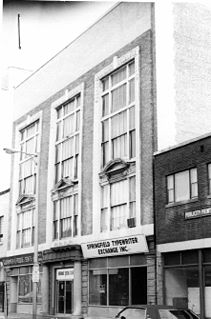
The Hibernian Block was a historic commercial building at 345-349 Worthington Street in downtown Springfield, Massachusetts. Built in 1910, it was a distinctive example of Classical Revival architecture, used for many years by a variety of fraternal social organizations. The building was listed on the National Register of Historic Places in 1983, and it was demolished sometime thereafter.

The Monroe Avenue Commercial Buildings, also known as the Monroe Block, is a historic district located along a block-and-a-half stretch at 16-118 Monroe Avenue in Detroit, Michigan, just off Woodward Avenue at the northern end of Campus Martius. The district was designated a Michigan State Historic Site in 1974 and listed on the National Register of Historic Places in 1975. The thirteen original buildings were built between 1852 and 1911 and ranged from two to five stories in height. The National Theatre, built in 1911, is the oldest surviving theatre in Detroit, a part of the city's original theatre district of the late 19th century, and the sole surviving structure from the original Monroe Avenue Commercial Buildings historic period.

The House of Peace Synagogue is a former synagogue of the Beth Shalom Congregation in Columbia, South Carolina. It was originally located at 1318 Park Street. After the congregation moved in the 1935, the building was used for the Big Apple Club, which was an African-American night club. It was named to the National Register of Historic Places on August 28, 1979. In the early 1980s, the building was moved to its present location at the southeast corner of Hampton and Park Streets. In 1993, it was purchased by the Historic Columbia Foundation and is called the Big Apple.
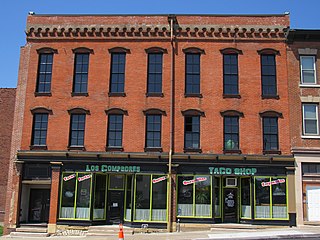
The Wupperman Block/I.O.O.F. Hall is a historic building located just north of downtown Davenport, Iowa, United States. It was individually listed on the National Register of Historic Places in 1983. In 2020 it was included as a contributing property in the Davenport Downtown Commercial Historic District.
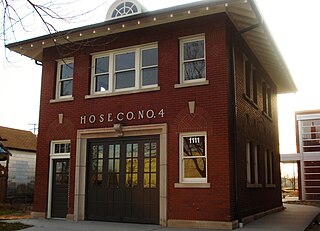
The Bohemian Commercial Historic District, also known as New Bohemia, is located in Cedar Rapids, Iowa, United States. It was listed on the National Register of Historic Places in 2002. At the time of its nomination it consisted of 75 resources, which included 48 contributing buildings, and 27 non-contributing buildings. Bohemian immigrants began settling in Cedar Rapids in the 1850s, and increasingly after the American Civil War in the 1860s and the Prussian War in Austria in 1880. They grew to be the largest ethnic group in the city, and the only one to settle in a distinct part of Cedar Rapids. They settled along the Cedar River between the downtown area and the T.M. Sinclair and Company meat packing plant. The buildings in the district were constructed between the 1880s and the 1930s. They are largely narrow-front commercial buildings and corner blocks. The buildings housed a variety of commercial establishments: a movie theater, two banks, and several filling stations. It also includes a railroad corridor factory building, a fire station, and fraternal halls. The buildings are representative of various commercial architectural styles and vernacular building forms popular at the times they were built. The Lesinger Block (1883) and the C.S.P.S. Hall (1891) are individually listed on the National Register of Historic Places.

The Malek Theatre, also known as The Malek, is an Art Deco theatre in downtown Independence, Iowa that was built in 1947. It replaced the Grand Theatre, which had burned on March 3, 1945. It was designed by Wetherell & Harrison for Bob C. Malek and was intended to be fireproof. It has a steel truss roof. A stepped tower at the front is made with structural glass and glass blocks. As of 2009 the interior was mostly original, with Art Deco style light fixtures and coved ceilings. Artist Merle Reed, of California, hand-painted its interior designs in 1945.

The Goodyear Block, also known as the Arbeiter Block is a commercial building located at 138 E. Main Street in Manchester, Michigan. It was listed on the National Register of Historic Places in 1993.

The West Liberty Commercial Historic District in West Liberty, Iowa, United States, is a historic district that was listed on the National Register of Historic Places in 2002. At that time, it included 41 contributing buildings, six other contributing structures, and eight non-contributing buildings.
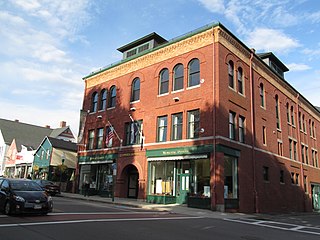
The Camden Opera House Block is a historic multifunction building at 29 Elm Street in the center of Camden, Maine, United States. Built in 1893 after the town's great 1892 fire, it is one of its most prominent buildings. It houses town offices, a social meeting hall, and a 500-seat theater. The building was listed on the National Register of Historic Places in 1986.

The Marshalltown Downtown Historic District is a historic district located in Marshalltown, Iowa, United States. It was listed on the National Register of Historic Places in 2002. At the time of its nomination it contained 96 resources, which included 79 contributing buildings, one contributing site, and 16 non-contributing buildings. The historic district covers most of the city's central business district. All of it is within the original town of Marshalltown, which was laid out and recorded on August 15, 1853, as the village of Marshall. Confusion with a town with the same name in Henry County led this village to be renamed Marshalltown in 1862. It was incorporated the following year.

Esquire Theater is a historic movie theater located at Cape Girardeau, Missouri. It was built in 1946–1947, and is a two-story, brick building with a colorful Art Deco facade. The building measures approximately 100 feet by 60 feet. It features a projecting marquee with neon tube lights; a streamlined, curving entrance and ticket booth; a projecting proscenium-like arch; and embellishments including enameled and stainless steel, structural pigmented glass, marble and glass blocks.

The Scampini Block is a historic commercial building at 289 North Main Street in the city of Barre, Vermont. Built in 1904, it is an elegant showcase of the skills of local granite carvers, and was for many years a social center for the area's large immigrant stoneworkers. It was listed on the National Register of Historic Places in 2007.

The Portland Downtown Historic District is a primarily commercial historic district located along Kent and Maple Streets, between Academy Street and the Looking Glass River, in Portland, Michigan. It was listed on the National Register of Historic Places in 2005.

The Woodlawn Commercial Historic District, in Birmingham, Alabama, was listed on the National Register of Historic Districts in 1991. It is a 6 acres (2.4 ha) district which included 12 contributing buildings and four non-contributing buildings in an area around the junction of 1st Avenue North and 55th Place in Birmingham, at the center of the community of Woodlawn, Alabama, which for a time was a separate city before being absorbed into Birmingham. A much larger portion of the community, including all of this Commercial historic district and residential areas as well, was later listed on the National Register as Woodlawn Historic District.






















